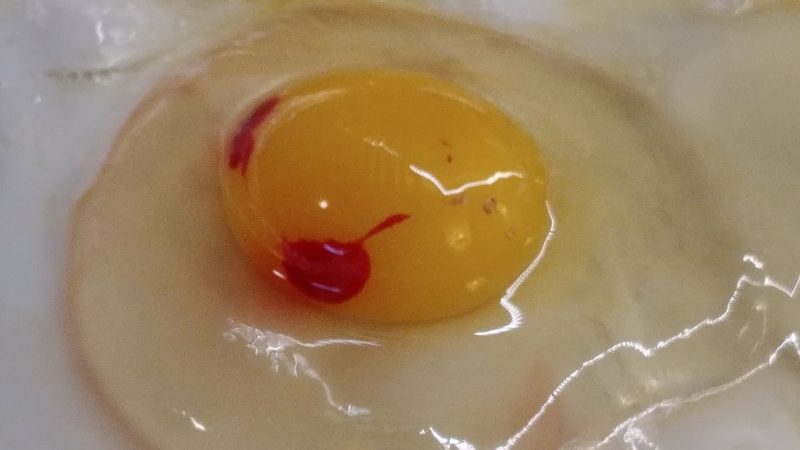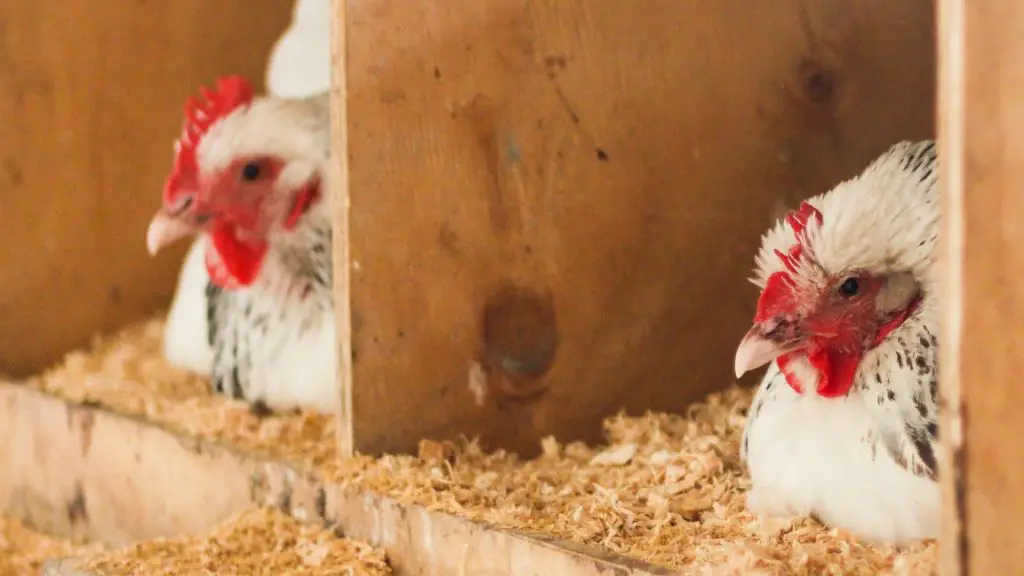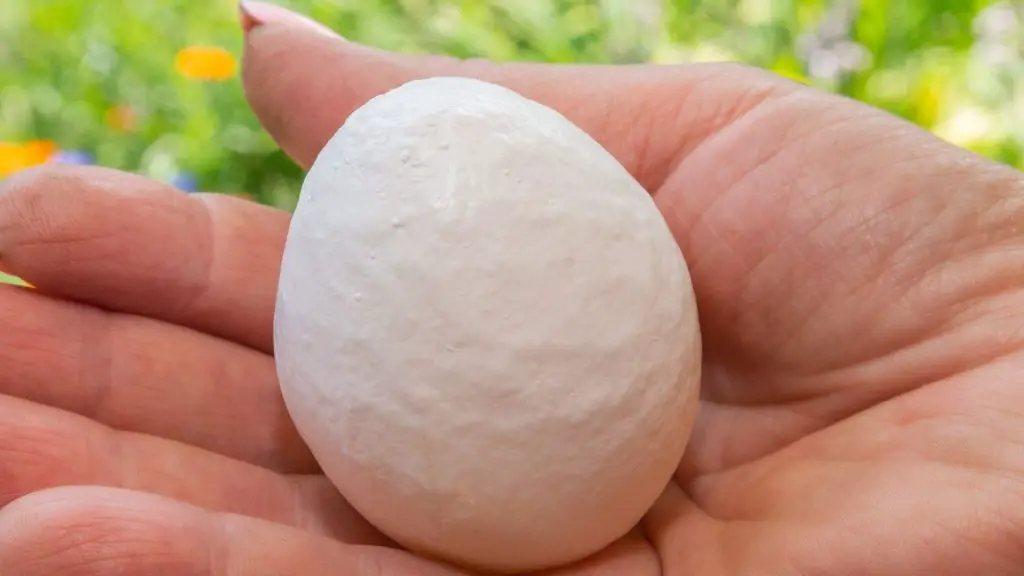It can be very alarming to find blood in your chicken eggs, especially when cooking or baking with them. However, once most people learn what causes this issue, they generally feel much better about finding a bit of blood in an egg now and then.
What causes blood spots in chicken eggs? Blood spots in chicken eggs happen when a blood vessel ruptures during yolk formation. They are harmless, and blood spots are safe to eat with the rest of an egg.
Read on for more information about chicken eggs and yolk irregularities.
What Does Blood in a Chicken Egg Mean?

Blood in a chicken egg is harmless and means there was an issue with the egg production process. However, if you don’t want to eat the blood, you can remove that small section of the yolk or get a new egg with which to cook.
It typically means that there was some disruption to the egg formation process. This can happen when the hen has experienced the following:
- Frightened by a rodent or something else.
- Vitamin deficiency.
- Exposed to anti-coagulants.
Spots could also be caused if a blood vessel passes over or across the yolk during egg formation. This does not mean your hen is injured, but blood on the outside of the shell may mean that she is.
These internal blood spots are harmless, and you can eat them safely. You won’t even notice them in the eggs after they are cooked. However, some may not want to eat these blood spots for different reasons.
Some diets do not allow blood consumption. People who follow strict Kosher or Halal diets are not allowed to eat blood. Thus, they must only eat eggs that do not have blood spots or other impurities.
Often, these blood spots can be removed and won’t affect the cooking process. You can scoop them out with a fork, spoon, or even knife and dispose of them.
What Does Blood on a Chicken Egg Mean?

Blood on the shell of an egg can mean a couple of different things, but the issue points to your hen. The blood can be on the outside of the egg if the hen has just started laying, suffers from vent fissures, is laying irregular eggs, or suffering from vent prolapse.
All of these issues have different severity levels and should be treated accordingly. The egg should be safe to eat as long as you wash it off and the shell isn’t damaged. However, if you wash off your egg, make sure to refrigerate or use the egg as soon as possible.
Washing an egg removes many of the natural protections that keep the egg from going bad. If this layer is removed, you need to take other steps to preserve the egg.
Related: How to Clean Chicken Eggs? | All You Need to Know!
Blood on a chicken egg can come from different reasons, such as the following:
If Your Hen Is New to Laying

If your hen is a young layer, she could be producing bloody eggs. This is because her body is still getting used to passing eggs.
Her vent needs time to stretch and move to pass an egg properly. Over time and age, your hen should get used to laying and not hurt herself anymore. This is a natural process, and there may occasionally be blood on the egg if it is particularly large or bumpy.
If Your Hen Has Vent Fissures
On the other end of the age spectrum, older hens are more prone to vent fissures. These are small fissures made when a hen is having trouble passing an egg. Her vent is stretching too much, and the skin tears as she lays the egg.
This issue heals itself most times, so as long as you keep an eye on her, she should remain perfectly fine and healthy. You might also consider putting some topical moisturizer on her vent to help with future stretching.
Vent fissures are common during types of arid weather and if a bird has had consistent diarrhea. These issues can chap the vent area, make laying very painful, and cause blood.
This is most common in older hens and maybe a sign that your bird is close to the end of her laying years. It means that her vent elasticity is fading. Make sure to keep an eye on hens that have fissures regularly and check them for signs of prolapse or infection.
If Your Hen Is Laying Irregular Eggs

Irregular eggs are another reason your bird might be bleeding.
Check the surface of the egg; if it has any particularly bumpy areas or any strange shapes, it may be causing your bird to hurt herself while laying. Overly large eggs are another example of irregular eggs that could damage your hen.
You should ensure your hens have access to plenty of calcium, such as crumbled oyster shell bits. Having healthy access to the shell will prevent your birds from producing bumpy or rough eggs that could cut them internally.
If Your Hen Is Experiencing Prolapse
Prolapse is severe and should be treated as a medical emergency. Hens of any age can experience prolapse, but it is more common in older and obese birds.
It is when a part of the hen’s internal organs are pushed out in the process of laying the egg. There will be a lot of blood, and the egg may not have left the hen’s organ. Your bird will likely be in great distress, so keep this in mind if you want to treat them yourself.
How to Treat Prolapse?
Once you identify which hen is experiencing prolapse, separate her from the rest of the flock.
You need to gather the following supplies:
- Warm water with antiseptic.
- Gloves
- A dark place alone from the rest of the flock.
Once you’ve done this, you can start treating the hen:
Step 1: Carefully wash the prolapsed area with warm water and antiseptic. Remove any debris that may have been collected and treat the area gently; you don’t want to hurt the hen more.
Step 2: Check to see if there is still an egg in the prolapse. If there is, you should very gently remove it. Make sure you don’t break the egg. Broken eggs could cut your chicken or leave pieces of the egg that could become moldy and hurt your bird even more.
Step 3: Once the egg has been removed and the prolapse cleaned, you need to return the prolapse into your hen’s body. This is an intimidating but relatively simple process.
Step 4: Carefully tuck your chicken’s head under your arm and hold them securely. Using a clean or gloved hand, carefully tuck the prolapse back into your chicken’s vent. You can also use a clean cloth to push it in.
It’s imperative to keep this process hygienic. If the prolapse is not kept clean, you could risk giving your bird an infection.
Step 5: Once you have put the prolapse back, you should do everything you can to prevent your hen from laying for the next couple of days. Place your hen in a dark place and give her limited access to food and water.
Step 6: Continue to monitor your hen’s behavior and keep her separated for several days. Other chickens could start picking at the prolapse and cause infection or relapse.
It is crucial to keep an eye on any bird who has had a prolapse before. If your chicken starts having frequent prolapses, this is a warning sign that she has serious trouble laying and may be coming to the end of her life.
Frequent prolapses signify that a bird’s body is deteriorating and can be very dangerous from blood loss. You should take your bird to a registered poultry vet if prolapse continues. Prolapse can quickly spiral into viral or bacterial infections if they happen repeatedly.
Related: How to Start a Chicken Egg Farm? | Tips and Guide
List of Sources
Processing and Marketing Eggs and Poultry Meat
